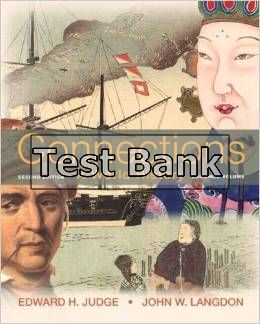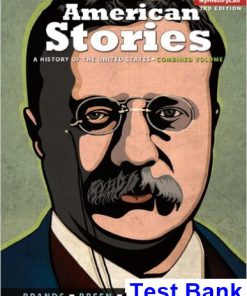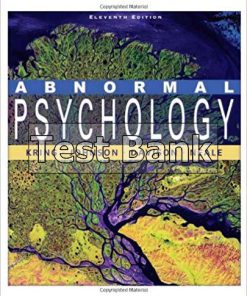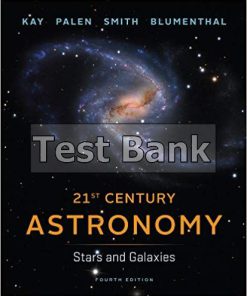Connections A World History Combined 2nd Edition Judge Test Bank
$26.50$50.00 (-47%)
Connections A World History Combined 2nd Edition Judge Test Bank.
You may also like
-
$26.50
$50.00 -
$26.50
$50.00
This is completed downloadable of Connections A World History Combined 2nd Edition Judge Test Bank

Product Details:
- ISBN-10 : 0205835503
- ISBN-13 : 978-0205835508
- Author:
Connections: A World History is a reader-centered text that focuses on connections within and among world societies. Concise, engaging chapters and a clear narrative make the often overwhelming amount of information in world history accessible to a wide range of readers. A uniquely comprehensive and consistent map program is combined with strong pedagogical support for increased understandability. The authors’ focus on connections offers a useful and compelling framework for understanding how and why peoples and societies change over time.
Table of Content:
Part I: Emergence and Expansion of Regional Societies, To 300 C.E.
Chapter 1 The Emergence of Human Societies, to 3000 B.C.E.Our Earliest Ancestors
Hominids and Cultural Adaptation
Foraging, Family, and Gender
Ice Age Migrations and Homo Sapiens
Physical and Cultural Diversity
Paleolithic Cultural and Spiritual Perspectives
Intercultural Connections and Conflicts
The Origins and Impact of Agriculture
The Origins of Farming and Herding
Agricultural Innovation and Expansion
Foragers, Hunter-Farmers, and Pastoral Nomads
Agricultural Society: Village, Family, and Land
The Impact of Agriculture
The Emergence of Complex Societies
Towns, Cities, Occupations, and Religion
States and Civilizations
Chapter Review
Chapter 2 Early Societies of West Asia and North Africa, to 500 B.C.E.
Early West Asian Societies
Early Mesopotamia: The City-States of Sumer
The Akkadian Conquest and Spread of Sumerian Culture
Babylonian Society and Hammurabi’s Code
Indo-European Migrations
The Hittite Connection
Later Mesopotamia: Assyrians and Chaldeans
Early Northeast African Societies
Egyptian Culture and Society
The Kingdoms of Egypt
Nubian Culture and the Kingdoms of Kush
The Kingdom and Culture of Meroë
West Asia and North Africa: The Phoenician Connection
The Israelites and Their God
The Children of Israel
The Kingdoms of Israel
The God of Israel
Chapter Review
Chapter 3 Societies and Beliefs of Early Indai, to 550 C.E.
The Indian Subcontinent
Harappan India: Early Indus Valley Societies
The Early Cities
Farming, Culture, and Commerce
The Decline of Harappan Society
Vedic India: The Aryan Impact
Aryan Incursions and the Rise of Vedic Culture
The Emergence of Caste
Family, Status, and Stability
The Religions of India
Jainism: Reverence for All Living Things
Buddhism: The Path to Inner Peace
Hinduism: Unity amid Diversity
Post-Vedic India: Connections and Divisions
Conflicts and Contacts with Persians and Greeks
The Rise of the Mauryan Empire
Ashoka’s Reign: Buddhism and Paternalism
India After Ashoka: New Connections and Conflicts
Indian Society and Culture
Caste, Family, and Gender
The Visual Arts
Science and Mathematics
Philosophy and Literature: Upanishads and Epics
Chapter Review
Chapter 4 The Origins of the Chinese Empire, to 220 C.E.
China’s Geographic Diversity
Early Chinese Societies
Predynastic China
Xia and Shang Societies
Chinese Writing
State and Society During the Zhou Dynasty
The Mandate of Heaven and Dynastic Cycle
Conflict, Chaos, and Commerce
The Central Asian Connection
The Classical Age of Chinese Philosophy
Confucianism: Noble-Minded Conduct and Familial Respect
Daoism: The Way That Cannot Be Spoken
Yin and Yang: The Balance of Forces in Nature
Legalism: Regulation, Coercion, and Control
The Birth of the Empire Under the Qin Dynasty
The First Emperor
The End of the Qin Dynasty
The Growth of the Empire Under the Han Dynasty
The Early Han: Confucian Bureaucracy and Military Expansion
Rebellion, Reform, and Ruin
The Later Han: Revival and Decline
Society, Technology, and the Silk Road
Han Society
Technical and Commercial Creativity
The Silk Road and the Sea Trade
Chapter Review
Chapter 5 Early American Societies: Connection and Isolation, 20,000 B.C.E-1500 C.E.
Origins and Arrival of the Amerinds
The Amerinds of North America
Two Hunter-Gatherer Bands
Five Limited-Scale Tribal Societies
Four Full-Scale Tribal Societies
Three Complex Societies
The Amerinds of Mesoamerica
The Olmec of the Preclassic Period (1800 B.C.E.–150 C.E.)
The Maya of the Classic Period (150–900 C.E.)
Teotihuacán: Rise and Fall of a Great City-State
The Toltec: Conflict Between Warriors and Priests
South America: Societies of the Andes
Hunter-Gatherers and the Chavín Society
Nazca and Moche Societies
Tiahuanaco, Huari, and Chimor
Chapter Review
Chapter 6 The Persian Connection: Its Impact and Influences, 2000 B.C.E-637 C.E.
The Persian Empire
Geographic Challenges Confront the First Persians
Cyrus the Great
Persian Governance and Society: Links with Mesopotamia
From Cyrus to Darius
Administration of the Empire
Mesopotamian Influences: Law, Administration, and Commerce
Persian Society and Culture
Zoroastrianism
A Religion of Good and Evil
Social and Political Content
Confrontation with Greece
The Ionian Revolt and the Persian Response
Xerxes and the Invasion of Greece
Stalemate
Persian Resurgence
The Macedonian Conquest and Its Successor States
The End of the Persian Empire
Persia Under Macedonian Rule
The Parthian Empire
The Sasanian Empire
Chapter Review
Chapter 7 Greek Civilization and Its Expansion into Asia, 2000-30 B.C.E.
Early Greece
Mycenae and Crete
The Polis
Archaic Greece, 700–500 B.C.E.
Greek Colonization and the Spread of Greek Culture
Rivalry Between Sparta and Athens
Classical Greece, 500–338 B.C.E.
The Persian Wars
Athenian Dominance and the Spartan Response
The Peloponnesian War
The Arts and Philosophy in Classical Greece
Architecture, Sculpture, and Pottery
Greek Drama
Philosophy
Classical Greek Society and Religion
Free Labor and Slavery
The Status of Women
Greek Religion
The Empire of Alexander the Great
Alexander’s Conquests
The Fate and Impact of Alexander’s Empire
Connections and Conflicts in the Hellenistic World
Commercial and Cultural Connections
Politics and Governance
Chapter Review
Chapter 8 The Romans Connect the Mediterranean World, 753 B.C.E.-284 C.E.
The Roman Republic to 133 B.C.E.
Rivalry with Etruria
The Republic and Its Foundation in Law
The Punic Wars and Rome’s Mediterranean Domination
Changes in Society and Culture
Dissatisfaction with the Republic
Social Discontent and Decline in Popular Rule
Julius Caesar
The Birth of the Roman Empire
The Rise of Octavian
From Republic to Empire
Greco-Roman Culture
Challenges to Augustus’s Work
Roman Religion and the Rise of Christianity
Rome’s Polytheistic Religion
Jewish Resistance and Eastern Cults
Paul of Tarsus and the Spread of Christianity
From Golden Age to Disarray
Commercial Connections
The Empire in Disarray
Chapter Review
Part II: Trans-Regional Conflicts and Religious Connections, 200–1200 C.E.
Chapter 9 Germanic Societies and the Emergence of the Christian West, 100-1100 C.E.
The Germanic Peoples
Germanic Society: Kinship and Combat
Germanic Migrations and Their Threat to Rome
The Decline of the Western Roman Empire
The Divided Empire and Its Eastern Orientation
The Triumph and Transformation of Christianity
Crisis and Chaos in the West
The Fall of Rome and End of the Western Roman Empire
Early Medieval Europe: Germanic and Christian Connections
The Emergence of Germanic Kingdoms
The Early Medieval Church: Expansion and Adaptation
The Franks and Their Effort to Reunite the West
Vikings, Muslims, and Magyars: Invasions and Connections
Europe’s Warrior Nobility: Protection, Land, and Power
Economy and Society: Manors, Lords, and Serfs
The Decline and Revival of the Western Church
From Scandal to Reform
The Great Schism of 1054
The Power of the Popes
Chapter Review
Chapter 10 The Byzantine World, 284-1240
The Foundations of Byzantine Governance
Constantine and the Christian Church
The Union of Church and State
Early Byzantium: Challenges and Survival
Justinian and Theodora
Byzantine Society
Crises of the Seventh Century
Eastern Christianity’s Culture and Conflicts
Foreign Conflicts and Byzantium’s Decline
The Arab Conflict
The Turkish Conquests
Pre-Christian Russia
Russia’s Difficult Climate and Terrain
Early Cultures and Conflicts
Kievan Rus Connects to the Byzantine World
The First Period: Early Rulers and Campaigns
The Second Period: Connections to Christendom
The Third Period: Chaos and Conflict
Economy and Society
The End of Early Russian Civilization
Chapter Review
Chapter 11 The Origins and Expansion of Islam, 100-750
Pre-Islamic Arabia
Camels and Commerce
The Collapse of Southern Arabia and the Rise of Mecca
The Rise of Islam
The Prophet Muhammad
From Mecca to Medina
Islam Expands, 632–661
An Agreement Between Leader and Followers
The Challenge to a Unified Islam
The Umayyad Caliphate, 661–750
Umayyad Expansion
Collapse of the Umayyad Caliphate
Society and Culture in Early Islam
Religious Observance: The Mosque
Legal Uniformity: The Shari`ah
Tolerance of Other Faiths
Chapter Review
Chapter 12 Religion and Diversity in the Transformation of Southern Asia, 711-1400
Islam Expands Eastward
Islamic Persia and the Abbasid Caliphate
Persian Influences on Islamic Governance and Culture
The Impact of Shi’ite Opposition
The Rise of Baghdad
Cosmopolitan Islam
Abbasid Governance
Commerce and Culture in the Abbasid Caliphate
Sufis and Fundamentalists
The Decline of the Abbasid Caliphate
Forces of Disintegration
Continuity of Islamic Unity and Expansion
The Gupta Empire in India
Gupta Rule and Achievements
Conflict and Collapse
The Islamic Impact on India
Islamic Invasions from Persia
Conflict and Connection: Muslims and Hindus
India’s Influence on Southeast Asia
Funan: The First Southeast Asian State
The Cambodian Empire
Srivijaya: Coalition and Cultural Blend
Chapter Review
Chapter 13 Early African Societies, 1500 B.C.E.-1500 C.E.
Africa Before Islam
The Bantu Migrations: Cohesion in Diversity
Regional Cultural Adaptations
Clans and Kingdoms
African Traditional Religion
Early African Culture
Islamic Africa and Spain: Commercial and Cultural Networks
Islamic North Africa
Cosmopolitan Umayyad Spain
Fatimid Egypt
Trade Across the Sahara
Early Saharan Trade
Islam’s Interaction with West Africa
West African Kingdoms: Ghana and Mali
The Conversion of Ghana
Islamic Mali, 1200–1450
Ethiopia’s Christian Kingdom
The City-States of East Africa
Development of a Bantu-Arab Culture
East and West Africa Compared
The Bantu Connection: Central and Southern Africa
The Bantu Influence
Great Zimbabwe
Chapter Review
Chapter 14 The Evolution and Expansion of East Asian Societies, 220-1240 C.E.
China’s Age of Disunity, 220–589
The Three Kingdoms Era
Division, Invasion, Adaptation, and Migration
Central Asian Connections and the Arrival of Buddhism
The Spread of Buddhism in China
China’s Age of Preeminence, 589–1279
China Reunited: the Sui Dynasty, 589–618
China Triumphant: The Tang Dynasty, 618–907
China in Turmoil: Ten Kingdoms and Five Dynasties, 907–960
China Resurgent: The Song Dynasty, 960–1127
China Divided: Jurchens and Southern Song, 1127–1279
Highlights and Hallmarks of Chinese Society
Commercial and Technological Innovations
Spiritual, Intellectual, and Cultural Creativity
Urban and Rural Society
Vietnam and the Chinese Impact
Vietnam Under Chinese Dominion
Vietnamese Autonomy
Korea and the Chinese Impact
Early Chinese Influence in Korea
The Kingdom of Koryo, 935–1392
The Emergence of Japan
Early Borrowing from China
The Heian Era: Divergence from China
The Rise of the Warrior Class
Chapter Review
Part III: Cross-Cultural Conflicts And Commercial Connections, 1000–1650
Chapter 15 Nomadic Conquests and Eurasian Connections, 1000-1400
The Nomads of Central Asia
Herding and Horsemanship
Family and Social Structure
Contacts and Conflicts with Settled Societies
The Rise and Fall of the Seljuk Turks
The Seljuk Conquests
The Great Seljuk Empire
The Fragmentation of the Seljuk Realm
The Mongol Invasions
The Conquests of Genghis Khan
Reasons for Mongol Success
The Mongol Khanates: Conquest, Adaptation,and Conversion
East Asia: Khubilai Khan and His Mongol-Chinese Empire
Southwest Asia: Mongol Devastation and Muslim Resilience
Russia: Conquest, Tribute, and the Tatar Yoke
Central Asia: The Struggle to Maintain the Mongol Heritage
The Mongol Impact: Connections and Consequences
Trade and Travel: The Pax Mongolica
Exchanges of Ideas and Technologies
The Plague Pandemic
The End of the Mongol Era
Chapter Review
Chapter 16 The Resurgence of the Christian West, 1050-1530
Conflicts and Connections Between Europe and Islam
Christians and Muslims in Iberia
The First Crusade: “It Is God’s Will!”
The Muslim Response and the Later Crusades
Islamic Impacts on Western Commerce and Culture
The High Middle Ages
Agricultural Advances
The Growth of Towns and Trade
The Rise of Royal Authority
The Revitalized Roman Church
Intellectual and Cultural Developments
Exaltation of Women and Marriage
The Decline of the Middle Ages
The Avignon Popes
Famine, Plague, and Social Unrest
The Great Western Schism
Europe in Disarray
The European Renaissance
Roots and Attributes of the Renaissance
The Italian Renaissance
The Northern European Renaissance
Social and Political Effects
Chapter Review
Chapter 17 Culture and Conflict in the Great Islamic Empires, 1071-1707
The Conquests of Timur Lenk
Timur’s Strengths and Good Fortunes
Attack on the Ottomans
Timur as Warrior and Administrator
The Cosmopolitan Ottoman Empire
Ottomans and Byzantines
Mehmed the Conqueror
The Ottoman State and Society
Suleiman the Magnificent
A Faltering Empire
Safavid Persia: A Shi’ite State
Shi’ite Islam as a Unifying Force
Regional and Islamic Influence on Family and Gender Roles
The Mughal Empire: A Muslim Minority Rules India
The Delhi Sultanate in India
Babur: Founding the Mughal Empire
Akbar’s Reign of Cultural Accommodation
The Great Mughals
Chapter Review
Chapter 18 The Aztec and Inca Empires, 1300-1550
The Great Amerind Empires
The Aztec Empire
Tenochtitlán: City in the Lake
Exploitation and Human Sacrifice
Society and Culture
The Inca Empire
A Unified Empire
Society and Economy
Adaptation to the Andes
Governance and Religion
Aztec and Inca on the Eve of Invasion
The Invasion and Conquest of Mexico
The Arrival of the Spaniards
Encounter Between Aztecs and Spaniards
The End of the Aztec Empire
Reasons for the Spanish Victory
The Invasion and Conquest of Peru
Upheavals Among the Inca
Encounter Between Inca and Spaniards
Cajamarca and the End of the Inca Empire
Reasons for the Spanish Victory
Chapter Review
Chapter 19 The Global Exploration and Global empires, 1400-1700
The Iberian Impulse
Portuguese Overseas Exploration
Columbus’s Enterprise of the Indies
The Voyage of Magellan
The Portuguese Seaborne Empire
Empire in the Atlantic Ocean
Empire in the Indian and Pacific Oceans
Portugal’s Commercial Empire in 1600
The Spanish and Portuguese Empires in America
The Amerind Foundation
Slave Labor
Government and Administration
The Colonial Church
Society in the Iberian Empires
Amerinds and Europeans in North America
Coalitions and Contacts
The Coming of the Europeans
Disease and Demographic Decline
The Columbian Exchange
Chapter Review
Chapter 20 The West in an Age of Religious Conflict and GLobal Expansion, 1500-1650
The Protestant Reformation
Roots of the Reformation
The Lutheran Revolt
The Rising Tide of Rebellion
Henry VIII and the English Reformation
Calvin and the Elect
The Spread of Protestantism
The Catholic Counterreformation
The Council of Trent
The Roman and Spanish Inquisitions
New Religious Orders
Religious and Political Strife in Europe
The Spanish Catholic Crusade
The Wars of Religion in France
The Thirty Years War
The Globalization of Western Christianity and Commerce
Catholicism’s Global Expansion
Merchant Capitalism and Global Trade
Colonies, Commerce, and Religion
Western Society in an Age of Religious and Economic Change
Warfare, Disease, and Witch Hunts
Social Effects of Economic Expansion
Family, Gender, Education, and Diet
Changes in the Role of Religion
Chapter Review
Glossary
Photo Credits
Index
People Also Search:
connections a world history combined judge
connections a world history combined 2nd edition judge
connections a world history combined
connections a world history combined 2nd edition
connections a world history combined 2nd edition testbank download pdf
connections a world history combined 2nd edition download scribd












